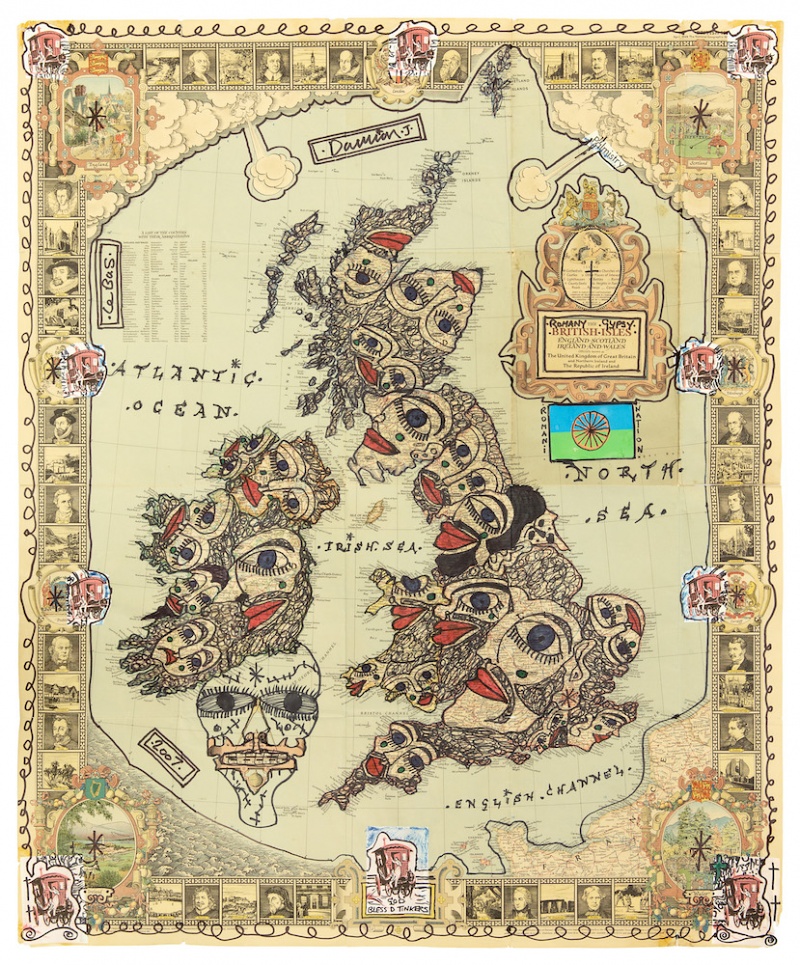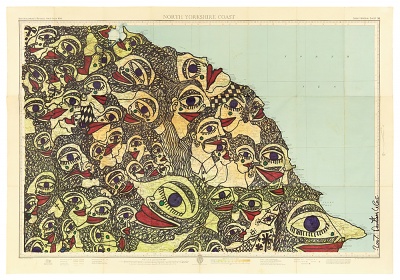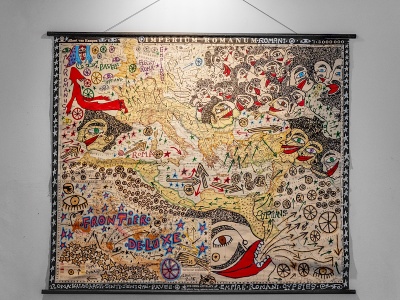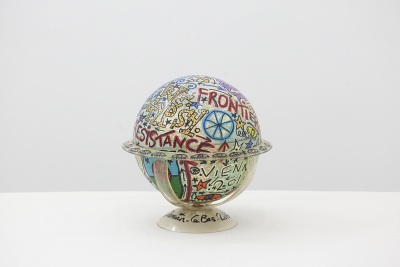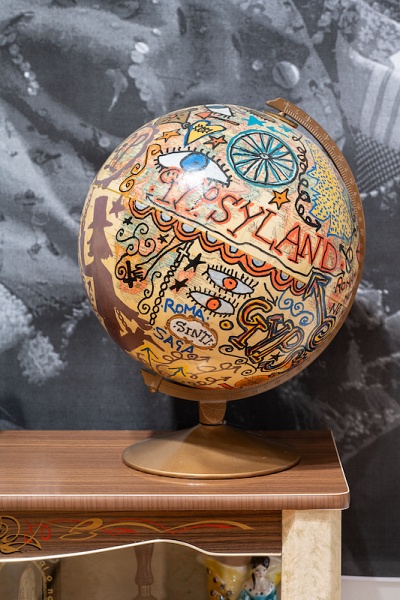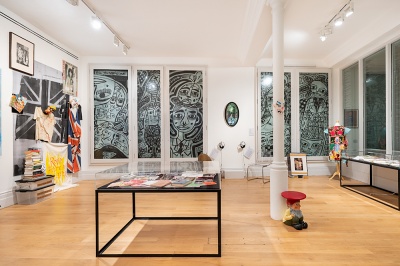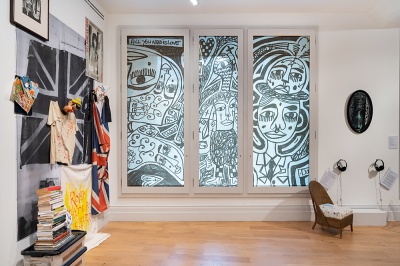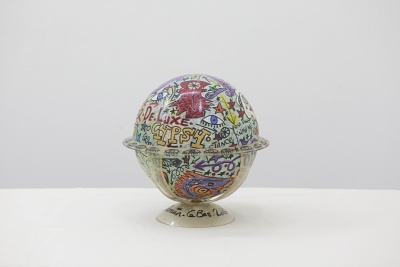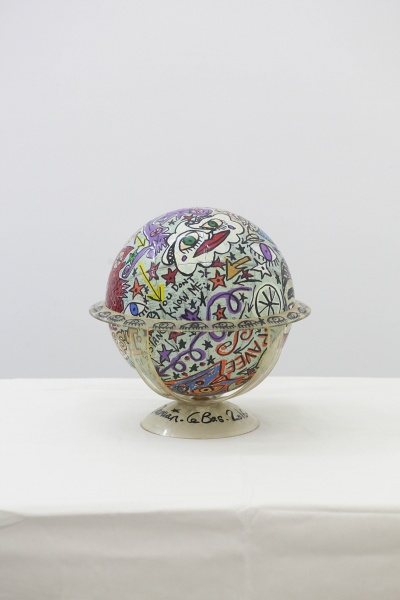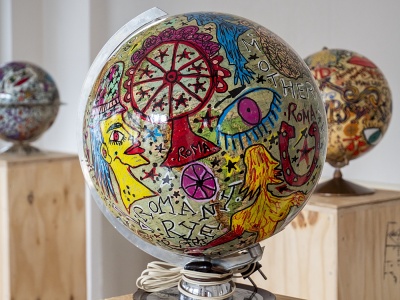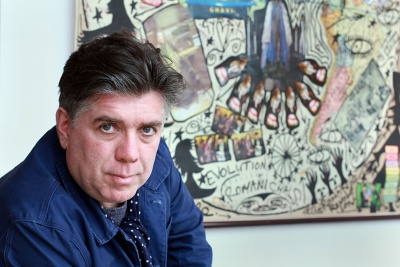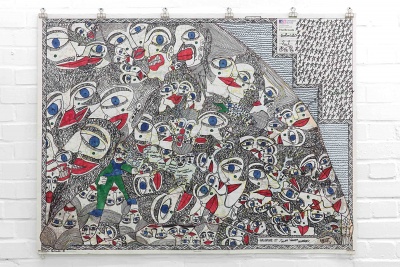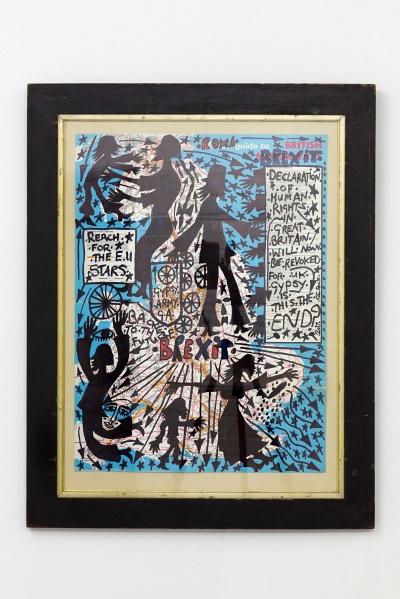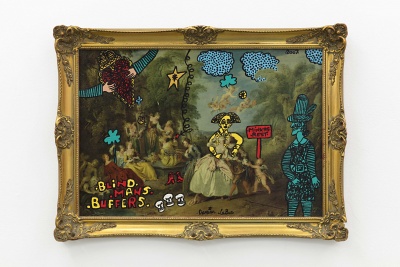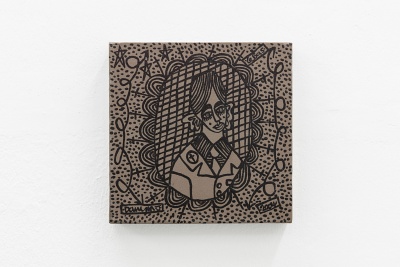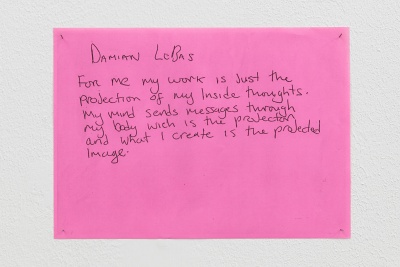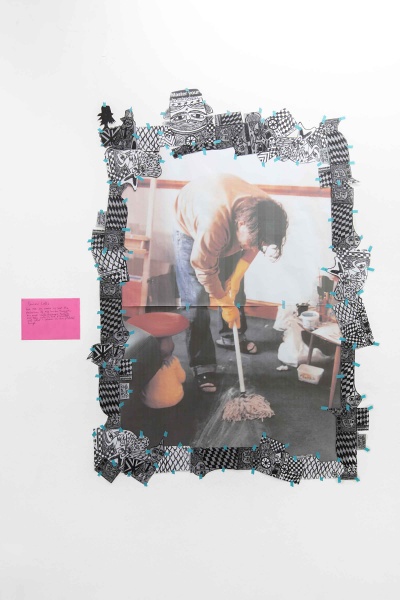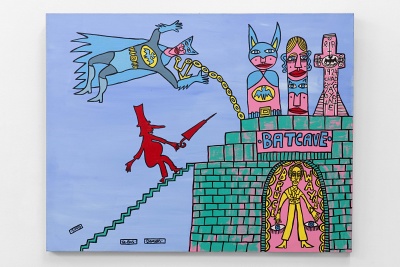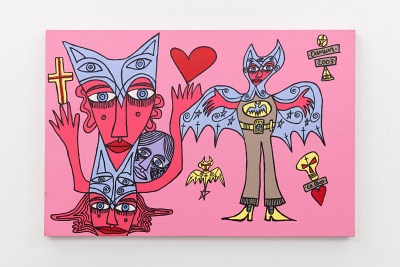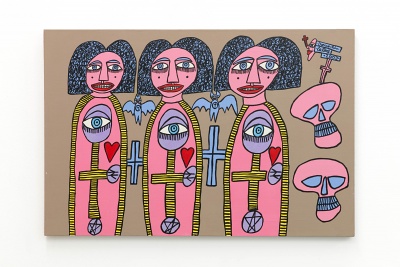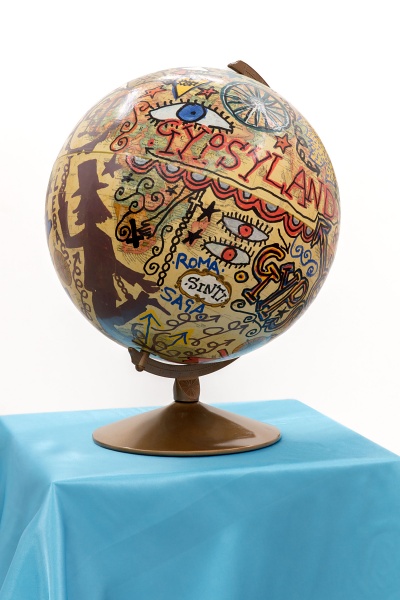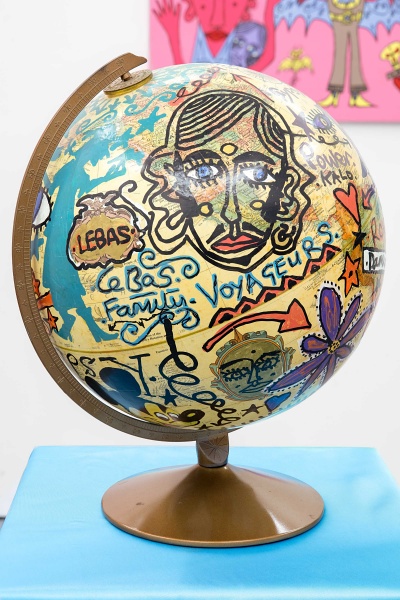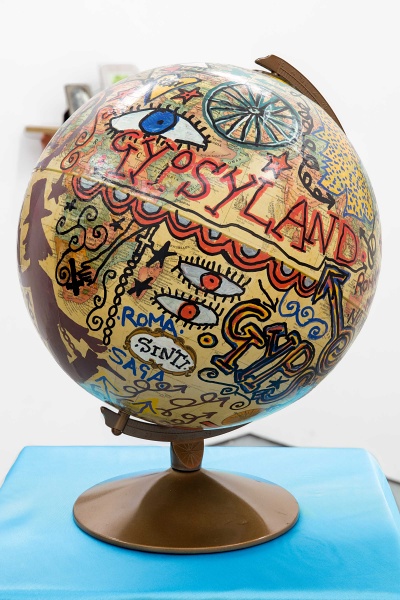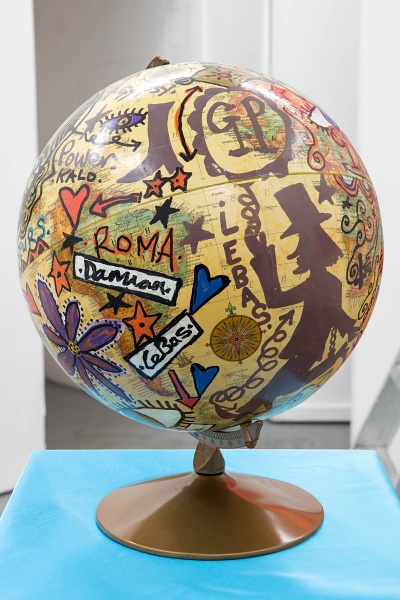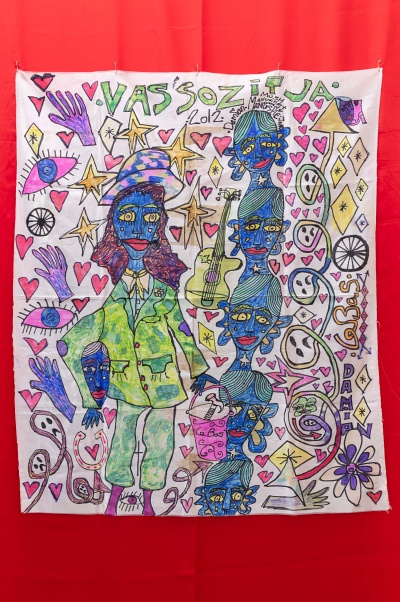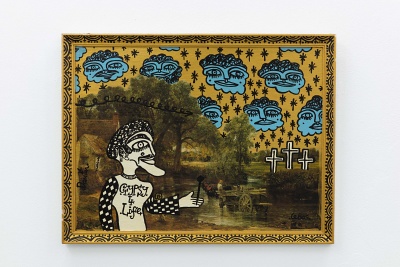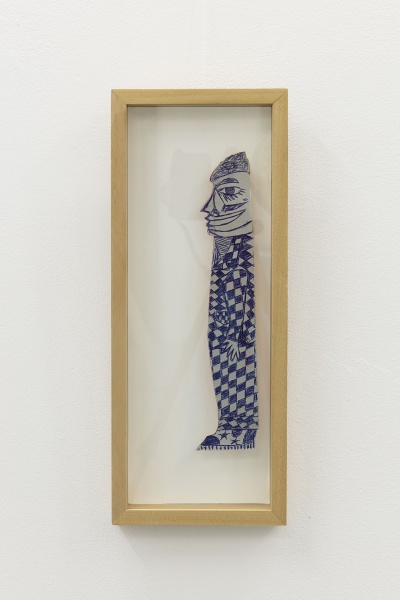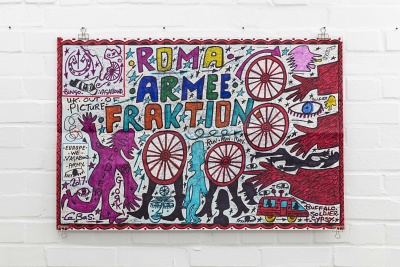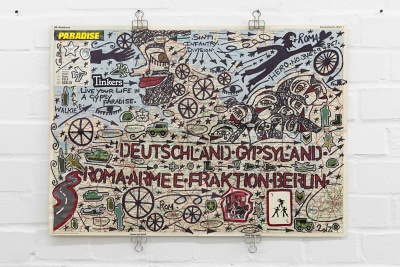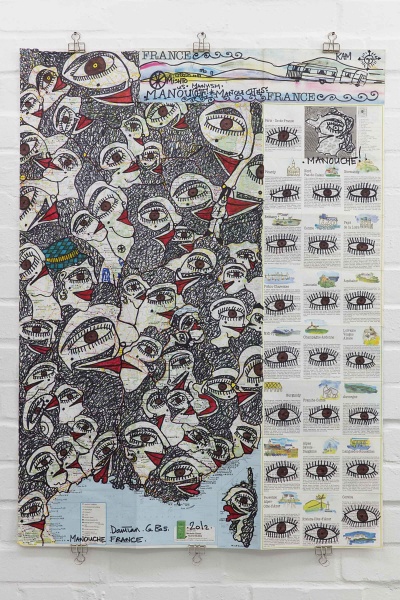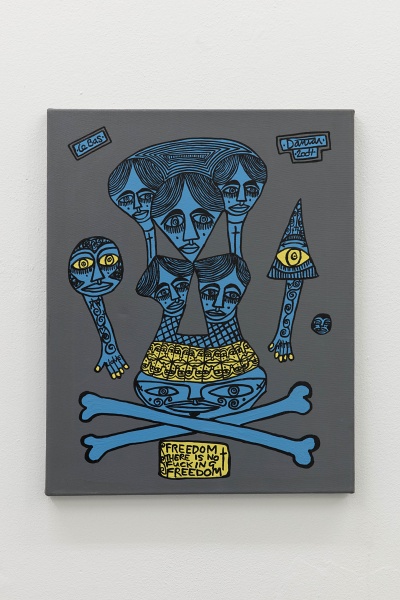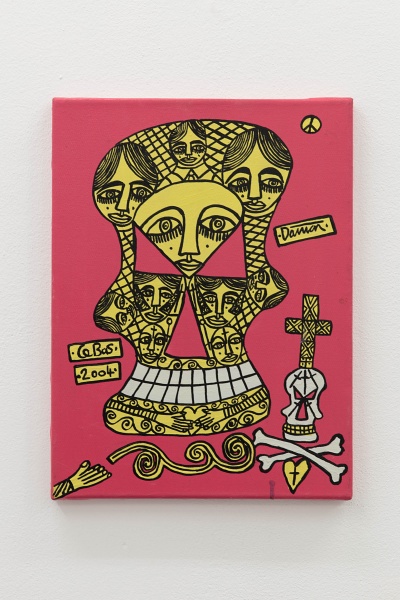Estate of Damian Le Bas
Damian Le Bas (b. 1963 Sheffield, d. 2017 Worthing), the creator of the eye-catchy, highly recognisable figures and symbolic objects that populates his paintings and installations, was a being full of contradiction. Always pushed to the peripheries both in life and in artistic career, Le Bas gradually crystallised the overwhelming frustrations into a strong drive for artistic activism advocating the causes behind the Roma communities from which he is hailed. Throughout his life full of turbulence, contested by stereotypes, bigotry, compounded by the glass barriers of the art world, he continued 'do his things' and made art, often viewed as an ‘outsider’ to the ‘mainstream’ art world. His sudden death in 2017 has left us a legacy of a pioneer artist/activist who advanced a cause for the international Roma, Gypsy, and Traveller communities, which, importantly, was fostered by his intuitive, humane sense for inclusion of all.
Born in Sheffield in 1963 to a mixed family, Le Bas had struggled to fit in all his life and was often at odds with authority. Accepted by enrolled in the Royal College of Arts when the conceptual art was at its height, the tutors there did not hide that they did not know what to do with his art, sometime uttering words of contempt for it and even suggested as had been before, that he would be better off switching career to 'stand-up comedy for his distracting jokes and music plays' *1. As much as he struggled to have his works recognised or taken seriously, his art school life was often revolved around 'hijinks and DJing Northern Soul party nights rather than learning'.*2
Despite perpetual and multiple adversities, Le Bas continued to create works staying faithful to his identity. He boldly expressed the deep narratives using traditional symbols, colourful imageries, intimate references, and rich resources of the Romany and Traveller cultures, never without a sense of lightness, fun, and a bit of self-depreciation which could be termed as a twisted expression of his Englishness.
Over the years, Le Bas learned to use his art as means for dialogue, and he dedicated his works to his widely spread roots and most significantly, championing the underrepresented Gypsy, Roma and Traveller communities which remained central to his practice and life. He explored such topics across an extensive variety of media including textiles, paintings, installations, mirrors and most distinctively or perhaps most powerfully, cartographies, maps, and globes. In these works, whole continents and the British Isles are covered by a trove of Le Bas's recurring character and what seems to be Le Bas alter ego, a silhouetted figure with a top hat as it disarmingly reflects a free utopia where borders, discriminations and persecutions faced daily by Romany Travellers are effortlessly overcome. His maps and globes symbolise the intrinsically transnational nature of the Travellers but the implication goes beyond the realm of Roma, essentially presenting us the idea of the world as one inclusive entity. Le Bas's map and globe works transcend the very purposes of the support materials which is to draw lines and divide between towns, cities and countries but the artist's cartography, on the contrary, unite.
“Gypsy Europa is my dream… My maps are subversive imaginary conquest, a Roma resistance against racism and right wing propaganda.” Damian Le Bas*3
'In his artworks, Damian Le Bas is a cartographer who is fully aware of the geopolitics of identity and representation, and who has turned maps into places of experimentation into how diverse tracings could be combined and set in motion to see things differently.' *4
Unmistakable political consciousness behind even these deeply intimate works has gradually propelled Damian Le Bas to a position of one of the leading exponents of the European Roma emancipation movement. In a non-confronting yet resounding manner, Le Bas became a role model in artistic activism for Roma rights while simultaneously contributing to the appreciation of Outsider Art or Art Brut, a unique art niche that is born outside the traditional academic fine art. Gypsy Dada is what Le Bas would describe as his personal form of Romani art, surreal and subversive. His works were his tools to fight for the universal recognition of Roma and extending the visibility of the Gypsy community to the wider world. A series of artistic projects lead to more open conversations, bringing awareness of the subject to institutions and general audience, attesting the power and impact of Le Bas's subversive art as effective means for political commentary and resistance.
While little appreciated during his lifetime, Le Bas’s artistic contributions and achievements are testament to the very prescient and universal nature of his body of work. It echos and parallels in a wider context across minority communities, and pronounced social awareness among general public in recent years renders his works increasingly more relevant and compelling, which convey urgent and universal messages to the world we live in.
Together with his wife, the artist Delaine Le Bas, they were one of the sixteen artists who took part in Paradise Lost, the first Roma Pavilion as a collateral event for the 52nd Venice Biennale in 2007. He was also the initiator of the first Roma Biennale in 2018, a project which he had advocated persistently over many years, although he was not able to see it come to fruition due to his untimely passing in 2017.
His works have been exhibited widely in the UK and internationally. Alongside the Roma Pavilion (2007), Roma Biennale (2018), the list also includes Prague Biennials (2005, 2007); The Third Edition Of The Project Biennial Of Contemporary Art: D-0 Ark Underground in Bosnia and Herzegovina (2015), 3. Berliner Herbstsalon and Romani History X at Maxim Gorki Theater in Berlin (2017) where Le Bas enjoyed close collaborative partnership towards the last years of his life, including the majestic drape for the stage of the theatre production of 'Roma Armee,' with his signature silhouettes of men and all things Roma, activated electronically . 'Safe European Home?', a collaborative installations with Delaine Le Bas toured various cities beginning in 2011 and lasted until his death.
Notes
*1 : Damian Le Bas, Jr, 'Everything Painted Gold', Rawvision; Outside Art Brut, Winter 2018/19, pp38-45, p42
*2 : idem
*3 : https://worldromacongressart.c...
website of World Roma Congress
*4 : Huub von Baar, 'Decolonizing Canonical Roma Representations: The Cartographer with an Army', 'The Roma and Their Struggle for Identity in Contemporary Europe.' edited by Huub van Baar and Angéla Kóczé, 2020, New York
Damian Le Bas
Damian Le Bas (b. 1963, Sheffield : d. 2017, Worthing) established a diverse practice across textile, collage, painting and performance, consistently resisting stereotype and categorisation. After completing an MA at The Royal College of Art, London, he exhibited at venues including Galerie Kai Dikhas, Berlin (2016), Kunstahalle Kallio, Helsinki (2012), the First Roma Pavilion for the Venice Biennale (2007) and the Prague Biennale (2007), and worked closely with Maxim Gorki Theater, Berlin on numerous projects including artwork for a musical 'Roma Armee'. He collaborated with Delaine Le Bas to create 'Safe European Home?', a series of installations exhibited across Europe since 2011 that explore identity, migration and borders. Challenging stereotypes and marginalisation, he initiated the Roma Biennale dedicated to art of Gypsy, Roma, Traveller and other communities which came to fruition posthumously in Berlin in 2018. In 2022, his work was featured in RomaMoMA at documenta 15, Kassel, Eurasia at Museum van Hedendaagse Kunst Antwerp and in 2023 he was a subject of an exhibition House of Le Bas at Whitechapel Gallery, London, on life and experience of the artist and his partner Delaine Le Bas, and also participated in a major group show Barvalo at MUCEM, Marseille. Currently some works are part of 'Who We Are' at Bundeskunsthalle, Bonn.
Downloads
VIDEOS
- Trailer for 'Roma Armee', a musical for Maxim Gorki Theater, Berlin
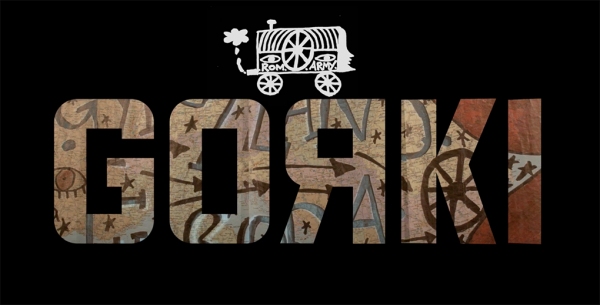
1 minute 31 secondsOfficial trailer for 'Roma Armee', a musical for Maxim Gorki Theater, Berlin, premiered in September 2017
director : Yael Ronen
painting and art work : Damian and Delaine Le Bas
Costume : Delaine Le Bas, Maria Abreu
video and animation : Hanna Slak, Luka Umek
